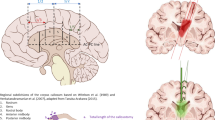Abstract
Introduction
Corpus callosum transection can prevent propagation of epileptic discharges. If seizures persist after surgery, assessment of the efficacy of the transection requires knowledge that the commissural fibers have been disrupted. We evaluated whether diffusion tensor imaging (DTI) and diffusion tensor fiber tracking can assess the degree of callosal transection and determine which white matter pathways remain intact.
Methods
This HIPAA-compliant retrospective study was performed after Institutional Review Board approval. Patients who underwent corpus callosotomy with postoperative magnetic resonance imaging (MRI) that included DTI were identified. Axial DTI was performed with either 15 or 25 noncollinear directions of encoding. MRI and DTI were reviewed by two board-certified neuroradiologists to evaluate commissural disconnection.
Results
One hundred eleven patients underwent corpus callosotomy with postoperative MRI, of which 32 had postoperative DTI. Of these 32, there were 16 males and 16 females, with a mean age of 12.2 ± 6.3 years (range 0.24 to 32.8 years, median 12.3). Eighteen patients had undergone complete callosal transection and 14 patients had partial callosal transection. Seventeen of 18 patients undergoing complete callosal transection had structural and diffusion tensor fiber tracking (DT-FT) evidence of complete transection. The forceps major was intact in all patients undergoing partial transection. At least some commissural fibers originating from the precuneus, postcentral gyrus, and posterior cingulate were intact in all six partial transections which spared the callosal isthmus.
Conclusion
DTI and DT-FT aid in the postoperative characterization in patients with callosal transection for seizure control. This can confirm whether the intended fibers have been disconnected, helping in the planning for possible further surgical intervention versus other therapies.




Similar content being viewed by others
Abbreviations
- DT-FT:
-
Diffusion tensor fiber tracking
- DE-FA:
-
Directionally encoded fractional anisotropy
- FA:
-
Fractional anisotropy
References
Raybaud C (2010) The corpus callosum, the other great forebrain commissures, and the septum pellucidum: anatomy, development, and malformation. Neuroradiology 52:447–477. doi:10.1007/s00234-010-0696-3
Tanriverdi T, Olivier A, Poulin N et al (2009) Long-term seizure outcome after corpus callosotomy: a retrospective analysis of 95 patients. J Neurosurg 110:332–342. doi:10.3171/2008.3.17570
Iwasaki M, Uematsu M, Sato Y et al (2012) Complete remission of seizures after corpus callosotomy. J Neurosurg Pediatr 10:7–13. doi:10.3171/2012.3.PEDS11544
Sunaga S, Shimizu H, Sugano H (2009) Long-term follow-up of seizure outcomes after corpus callosotomy. Seizure 18:124–128. doi:10.1016/j.seizure.2008.08.001
van Wagenen WP, Herren RY (1940) Surgical division of commissural pathways in the corpus callosum: relation to spread of an epileptic attack. Arch Neurol Psych 44:740
Le Bihan D, Breton E, Lallemand D et al (1986) MR imaging of intravoxel incoherent motions: application to diffusion and perfusion in neurologic disorders. Radiology 161:401–407
Pierpaoli C, Jezzard P, Basser PJ et al (1996) Diffusion tensor MR imaging of the human brain. Radiology 201:637–648
Moseley ME, Cohen Y, Kucharczyk J et al (1990) Diffusion-weighted MR imaging of anisotropic water diffusion in cat central nervous system. Radiology 176:439–445
Mori S, Crain BJ, Chacko VP, van Zijl PC (1999) Three-dimensional tracking of axonal projections in the brain by magnetic resonance imaging. Ann Neurol 45:265–269
Pillai JJ, Zaca D, Choudhri A (2010) Clinical impact of integrated physiologic brain tumor imaging. Technol Cancer Res Treat 9:359–380
Pizzini FB, Polonara G, Mascioli G et al (2010) Diffusion tensor tracking of callosal fibers several years after callosotomy. Brain Res 1312:10–17. doi:10.1016/j.brainres.2009.11.030
Moreno-Jiménez S, San-Juan D, Lárraga-Gutiérrez JM et al (2012) Diffusion tensor imaging in radiosurgical callosotomy. Seizure 21:473–477. doi:10.1016/j.seizure.2012.03.013
Concha L, Gross DW, Wheatley BM, Beaulieu C (2006) Diffusion tensor imaging of time-dependent axonal and myelin degradation after corpus callosotomy in epilepsy patients. Neuroimage 32:1090–1099. doi:10.1016/j.neuroimage.2006.04.187
Beaulieu C, Does MD, Snyder RE, Allen PS (1996) Changes in water diffusion due to Wallerian degeneration in peripheral nerve. Magn Reson Med 36:627–631
Khurana DS, Strawsburg RH, Robertson RL et al (1999) MRI signal changes in the white matter after corpus callosotomy. Pediatr Neurol 21:691–695
Hofer S, Frahm J (2006) Topography of the human corpus callosum revisited—comprehensive fiber tractography using diffusion tensor magnetic resonance imaging. Neuroimage 32:989–994. doi:10.1016/j.neuroimage.2006.05.044
Chepuri NB, Yen Y-F, Burdette JH et al (2002) Diffusion anisotropy in the corpus callosum. AJNR Am J Neuroradiol 23:803–808
Mukherjee P, Berman JI, Chung SW et al (2008) Diffusion tensor MR imaging and fiber tractography: theoretic underpinnings. AJNR Am J Neuroradiol 29:632–641. doi:10.3174/ajnr.A1051
Huisman TAGM, Schwamm LH, Schaefer PW et al (2004) Diffusion tensor imaging as potential biomarker of white matter injury in diffuse axonal injury. AJNR Am J Neuroradiol 25:370–376
Huisman TAGM, Sorensen AG, Hergan K et al (2003) Diffusion-weighted imaging for the evaluation of diffuse axonal injury in closed head injury. J Comp Assist Tomography 27:5–11
Wozniak J, Krach L, Ward E et al (2007) Neurocognitive and neuroimaging correlates of pediatric traumatic brain injury: a diffusion tensor imaging (DTI) study. Arch Clin Neuropsychol 22:555–568. doi:10.1016/j.acn.2007.03.004
Conflict of interest
We declare that we have no conflict of interest.
Author information
Authors and Affiliations
Corresponding author
Rights and permissions
About this article
Cite this article
Choudhri, A.F., Whitehead, M.T., McGregor, A.L. et al. Diffusion tensor imaging to evaluate commissural disconnection after corpus callosotomy. Neuroradiology 55, 1397–1403 (2013). https://doi.org/10.1007/s00234-013-1286-y
Received:
Accepted:
Published:
Issue Date:
DOI: https://doi.org/10.1007/s00234-013-1286-y




